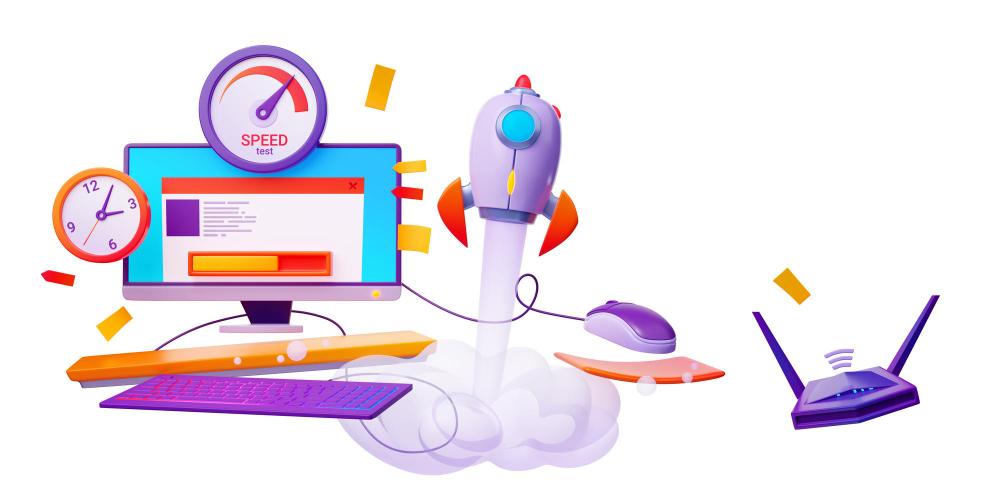Optimizing Your WordPress Website for Speed and Performance
In today’s fast-paced digital world, having a fast-loading website isn’t just a nice-to-have—it’s essential. Website’s speed and performance play an important role in how users experience your site. If your site takes too long to load completely, visitors might leave before they even see your content. This not only leads to a loss in potential customers but can also hurt your search engine rankings.
Google and various other search engines prioritize websites that load quickly. Therefore, your slow website can negatively impact your SEO, making it harder for people to find you online. Common reasons for slow website performance include large image files, too many plugins, and unoptimized code. In this article, we’ll walk you through simple steps to optimize your website’s speed and improve your WordPress performance.
Understand Website Speed and Performance
Website speed indicates how quickly your web pages load when someone visits your site. Faster websites provide a better user experience, keeping them engaged and urging them to explore more pages. Here are some key metrics to measure your WordPress performance and speed:
- Page Load Time: It’s the total time it takes for your page to fully load. Ideally, it should be under 2-3 seconds.
- Time to First Byte (TTFB): This metric indicates the time it takes for the web browser to get the first byte of data from the server. A lower TTFB signifies a quicker server response.
- Largest Contentful Paint (LCP): This measures how long it takes for the content of the page to become visible to the user. An LCP of 2.5 seconds or minimum is considered good.
However, to test your website speed, you can use tools such as Google PageSpeed Insights. These tools provide insights into your website’s performance and suggest improvements.
Common Causes of Slow WordPress Websites
Understanding what slows down your site is the first step toward fixing it. Here are some common reasons why WordPress websites may be slow:
- High-resolution images can make your site look great but can also slow it down.
- It’s true that plugins add functionality and useful features to your WordPress site; however, having too many can slow it down. Some plugins may not be optimized, which could cause performance issues.
- Not all hosting providers are equal. A low-quality hosting service can lead to slow server response times.
- Lack of caching also has a huge impact on your WordPress performance and speed.
- Unnecessary code can slow down your website’s loading time.
- Ads, fonts, and other external scripts can increase the time it takes for your site to load.
- A cluttered or poorly optimized database can also slow down your site.
Now that you know the reasons, let’s see how to optimize WordPress speed and performance.
Optimize WordPress Performance & Speed
Here are a few things that you must be careful about to make sure your site’s performance is good with great loading times:
Choose a Good Hosting Provider: A fast WordPress hosting provider is key to a fast-loading site. Look for managed WordPress hosting services that offer better speed and security than generic hosting plans.
Use a Lightweight Theme: Themes that are packed with features and heavy graphics can slow down your site. Choose a lightweight WordPress theme that is optimized for WordPress speed. Popular options include Astra, GeneratePress, and Neve.
Optimize Images for Web: Large images are often the biggest culprits for slow websites. Use image optimization tools like TinyPNG to compress your images without losing quality. Implement lazy loading to load images only when they come into view.
Minify CSS, JavaScript, and HTML: Minification reduces the size of your code files, making them load faster. Plugins like Autoptimize and WP Super Minify can help you minify your CSS, JavaScript, and HTML.
Enable Gzip Compression: Gzip compression decreases the size of files sent from your web server to the browser. This helps in reducing load time. You can enable Gzip compression using plugins or by adding code to your .htaccess file.
Use CDN: A Content Delivery Network (CDN) stores copies of your website’s files on servers around the world. This reduces the distance data has to travel, speeding up load times and improving WordPress performance. Popular CDN services include Cloudflare.
Implement AMP: Accelerated Mobile Pages (AMP) creates lightweight versions of your webpages for mobile users, improving mobile speed. You can use the AMP plugin for WordPress to implement this.
Reduce Number of Plugins: Audit your plugins regularly and remove those that are unnecessary or causing slowdowns. Deactivate and delete plugins you don’t need.
Optimize Your Database: Over time, your database can become cluttered with unnecessary data. Use tools like WP-Optimize to clean and optimize your database regularly, which ultimately improves your WordPress performance.
Limit External Scripts: External scripts, like those for ads or external fonts, can slow down your site. Limit their use and load them asynchronously when possible.
Use Fast and Reliable DNS: A good DNS provider can improve your website speed by quickly resolving domain names. Fast DNS services include Google DNS and Cloudflare DNS.
WordPress Caching: WordPress caching techniques are essential for improving site speed and performance by storing static versions of web pages and reducing the load on servers. There are various caching methods, including browser caching, where static files are stored in a visitor’s browser, and server-side caching, which stores data directly on the server for faster retrieval.
Plugins like WP Rocket and W3 Total Cache automate these processes, making them easy to implement. Additionally, object caching (which stores database query results) and opcode caching (which stores compiled PHP code) further enhance performance. So, implementing these caching techniques results in faster load times and a better user experience.
Monitor Website Performance Regularly: Regularly check your website’s speed to catch any issues early. Use tools like Uptime Robot and Pingdom to monitor your site and set up alerts for WordPress performance issues.
Conclusion
We concluded that optimizing your WordPress website for speed and performance involves several key techniques, such as choosing quality hosting, using a lightweight theme, installing caching plugins, and optimizing images. Moreover, regularly checking and maintaining your website speed is compulsory to ensure that it continues to perform well.
Remember, a fast website not only provides a better experience but also improves your WordPress performance and helps with search engine rankings. By investing time and effort into these optimizations, you can build a smoother, faster, and more efficient WordPress site that keeps visitors happy and engaged.




